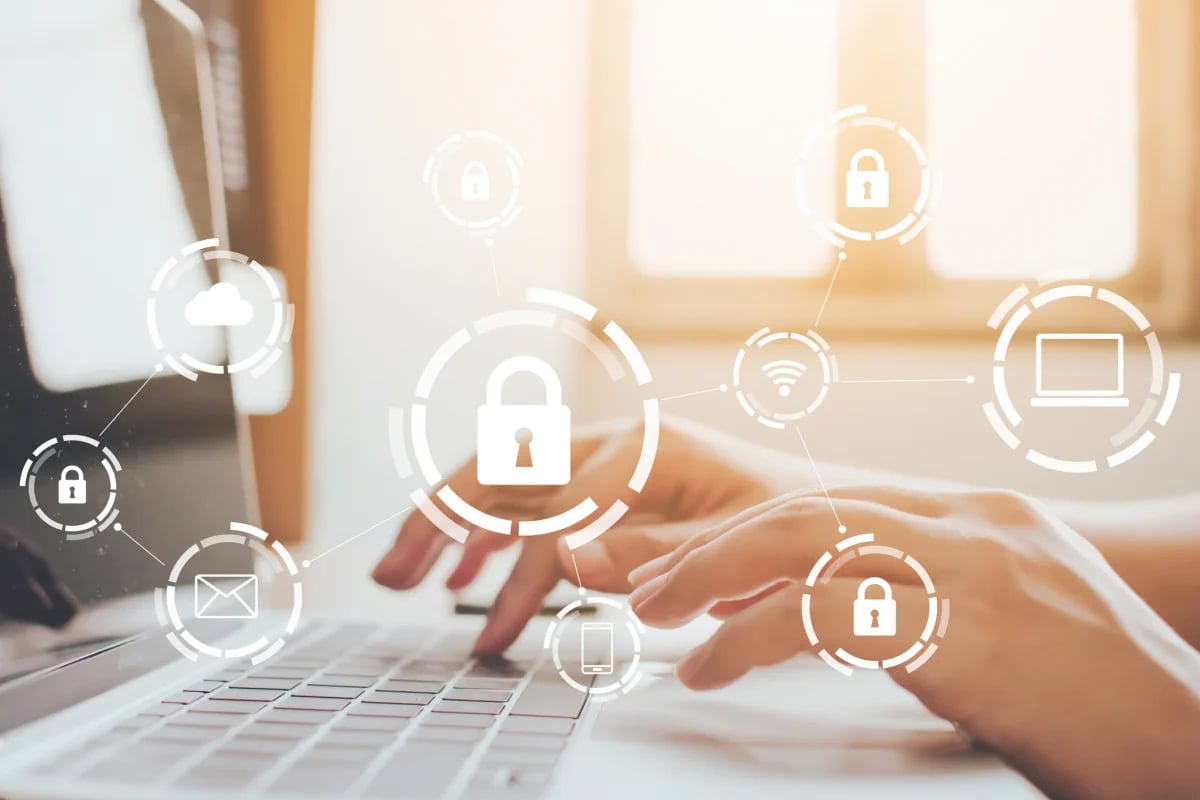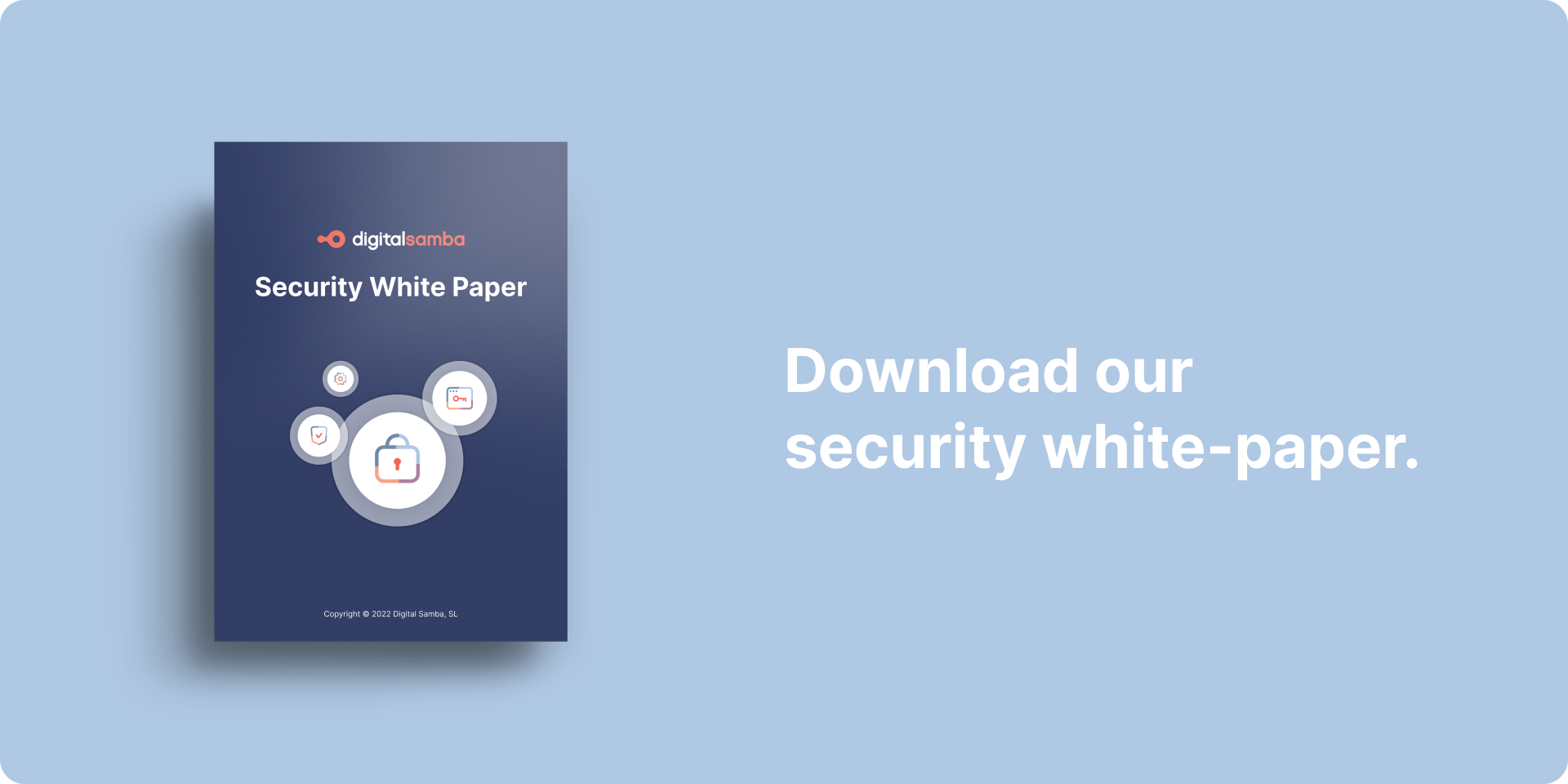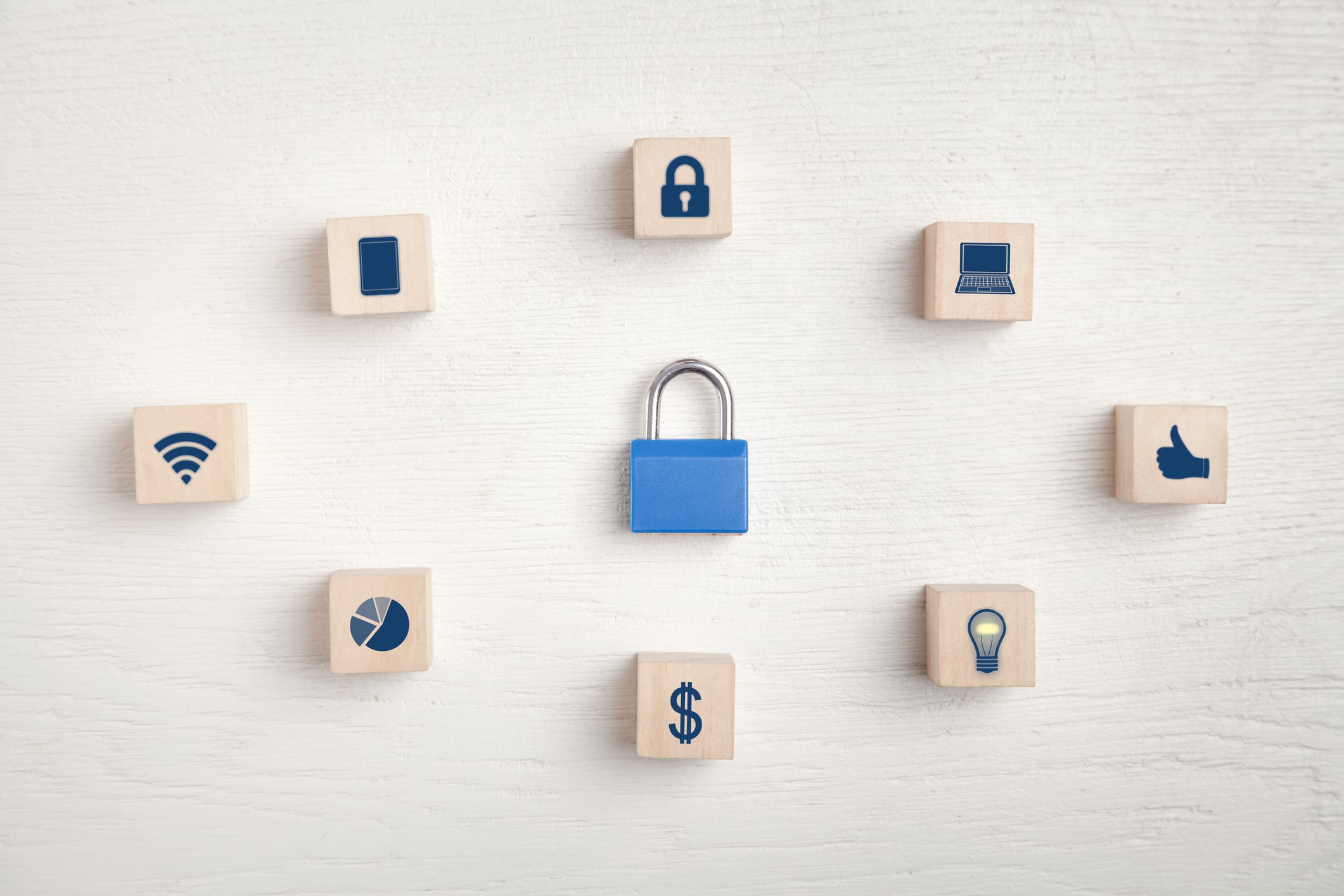Understanding WebRTC Security: Best Practices and Considerations
As real-time communication becomes critical to modern business, WebRTC (Web Real-Time Communication) has become the go-to solution for seamless video, audio, and data sharing—without the need for plugins or native apps. It's widely used in remote work, telehealth, education, and embedded video platforms.
However, this convenience comes with security challenges. WebRTC opens direct connections between users, which can lead to IP address exposure, data leaks, or unauthorised access if not properly secured. Encryption, authentication, and access controls are essential—not optional.
Table of contents
- Understanding WebRTC security
- WebRTC security concerns
- The role of WebRTC encryption in WebRTC security
- Why is application-level security necessary for WebRTC?
- WebRTC security best practices to secure WebRTC communications
- Enable secure real-time communications with Digital Samba
This article breaks down WebRTC security principles, common vulnerabilities, and the most effective best practices to help teams safeguard their communications in 2025 and beyond.
Understanding WebRTC security
WebRTC is a free, open-source technology that enables real-time peer-to-peer communication directly in web browsers and mobile apps. It powers video, voice, and data sharing between users without the need for plugins or external software.
Security in WebRTC isn’t an optional layer—it’s built into the protocol. WebRTC uses a combination of standards like end-to-end encryption (E2EE), secure signalling, and DTLS/SRTP protocols to protect user data during transmission. These technologies ensure that media streams and data packets are encrypted, helping prevent interception or tampering.

That said, encryption alone isn't enough. WebRTC sessions can still be exposed to threats like IP leaks, man-in-the-middle attacks, or poor implementation practices. That’s why WebRTC security depends not just on the protocol, but also on secure browsers, updated operating systems, and how developers implement access controls within their apps.
Key security influences include:
-
Browser security – Modern browsers enforce sandboxing and secure origin policies, which help isolate and protect WebRTC sessions.
-
Operating system security – Keeping OS software up to date and using firewalls or antivirus tools helps protect endpoints.
-
Community-driven updates – As an open-source project, WebRTC benefits from continuous testing and improvement by global contributors, who help identify and patch vulnerabilities faster than in closed systems.
Together, these layers form the foundation of a secure WebRTC environment—but only when implemented thoughtfully.
WebRTC security concerns
Despite strong built-in encryption, WebRTC isn’t immune to security risks—especially when implementations are incomplete or poorly configured.
One of the most well-known risks is the WebRTC IP leak. Even when using VPNs or anonymisation tools, some browsers may inadvertently expose a user’s real IP address through WebRTC. This can compromise user privacy, reveal geolocation, or leak personally identifiable information (PII).
These leaks can compromise user privacy and sometimes expose identities even when anonymisation services are used. Alternatively, depending on your device and browser, implementing correct softwares such as Windows and Linux local security apps or a VPN service for Chromebooks might work to protect your devices against these leaks.
Other common WebRTC vulnerabilities include:
-
Weak signalling security – If the signalling channel (used to initiate connections) isn’t properly secured, attackers may intercept or spoof session setup data.
-
Lack of access control – Without authentication and role-based permissions, unauthorised users may access sessions or media streams.
-
Exposed TURN servers – Misconfigured TURN/STUN servers may leak IP data or allow abuse, especially if not secured with proper credentials or firewall rules.
-
Poor browser or app hygiene – Outdated browsers and insecure third-party scripts can introduce vulnerabilities into otherwise secure WebRTC setups.
Mitigation strategies include:
-
Disabling WebRTC when not needed (for general users).
-
Using VPNs in combination with browser settings that block IP leaks.
-
Regularly updating all browsers, operating systems, and WebRTC libraries.
-
Securing signalling channels with TLS and implementing strong identity verification.
While WebRTC is secure by design, these concerns show that real protection depends on full-stack security practices—not just the protocol itself.
A heap-buffer overflow bug in WebRTC
In 2022, Google discovered a heap-buffer overflow bug in WebRTC, which could be exploited for Denial-of-Service (DoS), remote code execution, and other high-severity risks.
The role of WebRTC encryption in WebRTC security
Encryption is at the core of WebRTC’s ability to deliver secure real-time communication. Because WebRTC enables direct connections between users’ devices, every piece of audio, video, and data transmitted must be protected from interception.
WebRTC uses a layered encryption model that includes:
-
SRTP (Secure Real-Time Transport Protocol) – Encrypts the actual media streams (audio and video), making them unreadable to anyone without the correct keys.
-
DTLS (Datagram Transport Layer Security) – Protects the key exchange process used to initiate SRTP, ensuring only the intended parties can decrypt the media.
-
Encrypted signalling (via TLS) – While not part of WebRTC itself, the signalling channel must be secured with HTTPS or WSS to prevent session hijacking or spoofing.
These layers work together to ensure that data remains private, tamper-proof, and inaccessible to third parties—even over public networks.
In addition to technical protection, encryption is now a legal requirement in many regions. Regulations like the GDPR mandate encryption of personal data in transit, making secure WebRTC implementation essential for compliance—especially in industries like healthcare, education, and finance.
For even stronger privacy, some developers add end-to-end encryption (E2EE), which prevents media from being decrypted even on intermediary servers like SFUs (Selective Forwarding Units).
Ultimately, encryption isn't just a feature—it’s a foundation. Without it, WebRTC sessions become vulnerable to spying, tampering, and data loss.
Why is application-level security necessary for WebRTC?
While WebRTC includes strong built-in encryption, relying solely on the protocol isn't enough to protect real-world applications. Application-level security fills the gap between the secure transmission of data and how that data is accessed, stored, and managed within your app.
Key reasons to implement application-level security:
-
Protect the signalling layer: WebRTC relies on external signalling protocols to establish connections. These signalling channels must be secured with TLS and include authentication to prevent spoofing or session hijacking.
-
Control user access and roles: Not all users should have the same permissions. Enforcing role-based access controls ensures that participants only access data and features relevant to their role (e.g. presenter vs viewer).
-
Secure media and TURN servers: TURN servers are essential when peer-to-peer connections can’t be established. If left open or misconfigured, they can become entry points for data leaks or abuse. Server authentication, IP whitelisting, and rate limiting are essential here.
-
Manage session integrity: Application logic should validate every user session, monitor activity for anomalies, and terminate sessions when threats are detected or a user becomes inactive.
-
Comply with privacy regulations: Application-level logging, user consent prompts, and encryption at rest are all needed to meet standards like GDPR, HIPAA, or ISO 27001.
In short, even the most secure WebRTC implementation is only as safe as the application surrounding it. Developers need to design with security in mind at every layer—from browser to backend.

The Digital Samba Security White Paper
Download now
WebRTC security best practices to secure WebRTC communications
Implementing WebRTC securely requires more than just turning on encryption. To fully protect your users and infrastructure, it's important to apply a combination of technical, operational, and architectural best practices.
Here are the top security practices to follow when deploying WebRTC in 2025:
-
Secure the signalling channel
Always use TLS (HTTPS or WSS) for your signalling servers. This prevents man-in-the-middle attacks and protects session metadata during connection setup. -
Use strong authentication and access control
Implement user authentication at the application level and assign permissions based on roles. Prevent unauthorised users from joining or hijacking calls. -
Prevent IP and DNS leaks
WebRTC can reveal internal IP addresses if not configured correctly. Use VPNs with leak protection and configure STUN/TURN servers to minimise exposure. -
Keep browsers and libraries updated
WebRTC relies on browser implementations. Regularly update your browsers, SDKs, and server components to ensure you have the latest security patches. -
Lock down TURN servers
Protect your TURN infrastructure with credentials, access restrictions, and rate limiting. Avoid running open or unauthenticated relays. -
Monitor and log sessions
Track session activity for anomalies. Logging access attempts and unusual behaviour helps detect misuse early and supports compliance audits. -
Encrypt recordings and stored data
If your platform allows session recording, make sure those files are encrypted at rest and access is tightly controlled. -
Conduct regular security audits
Perform penetration tests and code reviews to find and fix vulnerabilities. Follow a Secure Development Lifecycle (SDL) for all real-time features. -
Educate your team and users
Human error is a common attack vector. Provide security training for developers, support staff, and users on secure usage and privacy settings.
By following these practices, you’ll significantly reduce your exposure to common WebRTC risks—and better align with security frameworks and compliance requirements.
Enable secure real-time communications with Digital Samba
If you’re building a WebRTC-powered application, security can’t be an afterthought. Digital Samba’s video communication API is designed to give you full control over your real-time infrastructure—without compromising privacy or performance.
Hosted entirely in the EU, our platform is GDPR-compliant by design and includes end-to-end encryption, secure TURN infrastructure, and granular access controls. Whether you're embedding video in a healthcare app, virtual classroom, or enterprise portal, we help you stay compliant and secure.
Additional benefits include:
-
Low latency and high availability with 99.99% uptime
-
Seamless SDK and API integration with your frontend or backend
-
Built-in tools for user authentication, role management, and access policies
-
Full session logging and monitoring to support your compliance needs
With Digital Samba, you can deploy secure, embedded video experiences—confidently and at scale.
👉 Request a demo to see how it works in action.
FAQs: WebRTC security
1. Is WebRTC secure by default?
Yes, WebRTC includes built-in encryption (DTLS and SRTP) by default. However, overall security depends on how it’s implemented—especially the signalling, server infrastructure, and app-level controls.
2. Can WebRTC leak my IP address even with a VPN?
In some cases, yes. Certain browsers may expose internal IPs via WebRTC APIs unless configured properly. Using a VPN with WebRTC leak protection and secure browser settings can help prevent this.
3. Do I need to encrypt the signalling server if WebRTC already encrypts media?
Absolutely. Signalling data contains session metadata and credentials. It must be secured with HTTPS or WSS to avoid interception and session hijacking.
4. How do I stop unauthorised users from joining WebRTC sessions?
Implement strong authentication and access controls in your app. Use secure tokens or session IDs, enforce timeouts, and manage user roles to limit access.
5. Is it safe to store WebRTC call recordings?
It can be, but only if recordings are encrypted at rest, access is restricted, and the storage complies with data protection laws like GDPR or HIPAA.
6. What's the best way to secure TURN servers?
Require authentication (e.g. long-term credentials), restrict IP ranges, monitor traffic, and avoid open relays. TURN server misconfiguration is a common WebRTC vulnerability.
Share this
You May Also Like
These Related Stories

Digital Samba Introduces End-to-End Encryption (E2EE) for Private and Group Video Calls

Exploring End-to-End Encryption in WebRTC


